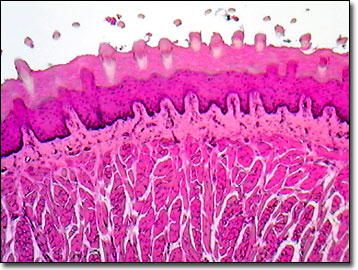Brightfield Digital Image Gallery
Tongue Muscle Stained Thin Section
The primary function of the tongue in mammals is to provide a mechanism for taste. As a muscle, the tongue is also important as a means of creating the negative pressure necessary for infants to suckle or nurse, an exclusively mammalian activity.

Other functions of the tongue include assisting in chewing, swallowing, grooming, and antiseptic cleansing of the mouth and open wounds that are licked. In humans, the tongue is extremely important because it enables spoken language, and for gourmands and gourmet chefs, it provides for a refined palate.
This organ is a mass of interwoven, striated muscle tissue, interspersed with glands and fat and covered with a mucous membrane. The top surface bears numerous projections of the mucous membrane, called papillae, which contain taste buds. Taste is one of two major forms of chemoreception that are dominant in the human experience, the other being smell. Taste buds are located on different areas of the tongue, but are generally found around the edges. They are sensitive to five main tastes: bitter, sour, salty, sweet, and umami (the taste associated with monosodium glutamate).
As striated muscle, human tongue muscle usually stains red, due to the orange G component of Mallory trichrome stain, as do some of the cytoplasmic elements. The genioglossus is the main tongue muscle and serves to hold the tongue in its forward position. During sleep, this muscle relaxes and may allow the tongue to fall into the air passageway. Attached to the middle of the lower jawbone, the genioglossus muscle is often responsible for annoying nighttime snoring, which is remedied in some cases through surgery on the bone. Other tongue muscles attach to the hyoid bone of the neck. They, as well, may be responsible for snoring and breathing problems that can be corrected by relocating the hyoid bone through routine surgery. Trumpeters and other horn (and reed instrument) players have very well developed tongue muscles, and are able to perform rapid, controlled movements or articulations referred to as "tonguing", a skill that can be improved through exercise and practice. Unlike humans and other primates, some reptiles, notably true chameleons and amphibians, can literally shoot their entire tongues at insects using highly developed spiraling muscle fibers.
A human trait that enables 70 percent of the population of European descent to roll their tongues into a tube shape is also controlled by tongue muscles, but is not a purely Mendelian inherited single-locus trait, as reported in older genetics textbooks. Reportedly, there are numerous cases in which identical twins are discordant for tongue rolling, and the recent Human Genome Project has failed to identify this elusive gene's location and coding.
Contributing Authors
Cynthia D. Kelly, Thomas J. Fellers and Michael W. Davidson - National High Magnetic Field Laboratory, 1800 East Paul Dirac Dr., The Florida State University, Tallahassee, Florida, 32310.
BACK TO THE BRIGHTFIELD IMAGE GALLERY
BACK TO THE DIGITAL IMAGE GALLERIES
Questions or comments? Send us an email.
© 1995-2025 by Michael W. Davidson and The Florida State University. All Rights Reserved. No images, graphics, software, scripts, or applets may be reproduced or used in any manner without permission from the copyright holders. Use of this website means you agree to all of the Legal Terms and Conditions set forth by the owners.
This website is maintained by our
Graphics & Web Programming Team
in collaboration with Optical Microscopy at the
National High Magnetic Field Laboratory.
Last Modification Friday, Nov 13, 2015 at 01:19 PM
Access Count Since September 17, 2002: 15016
Visit the website of our partner in introductory microscopy education:
|
|
